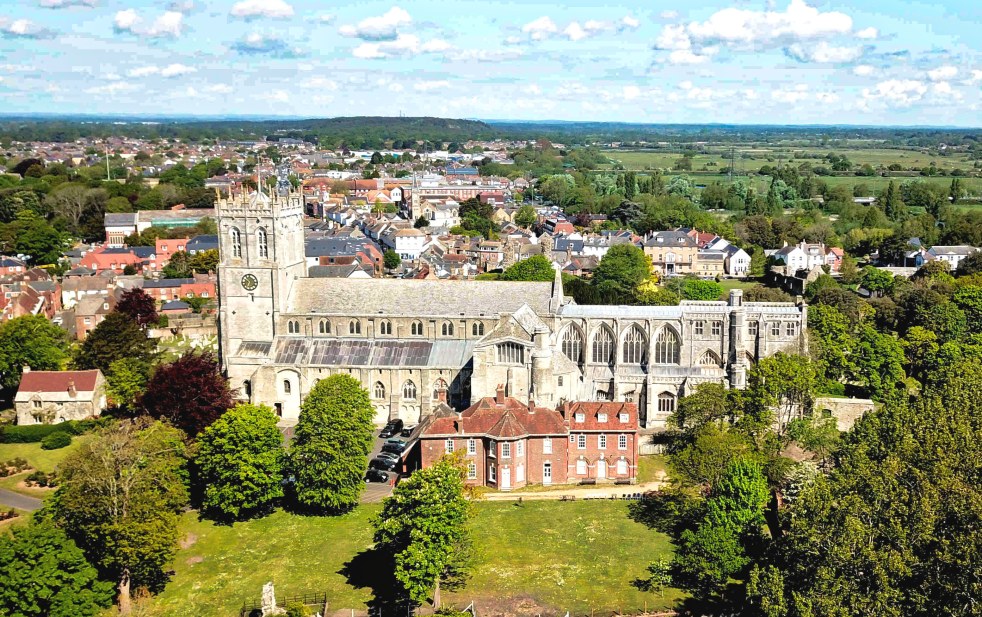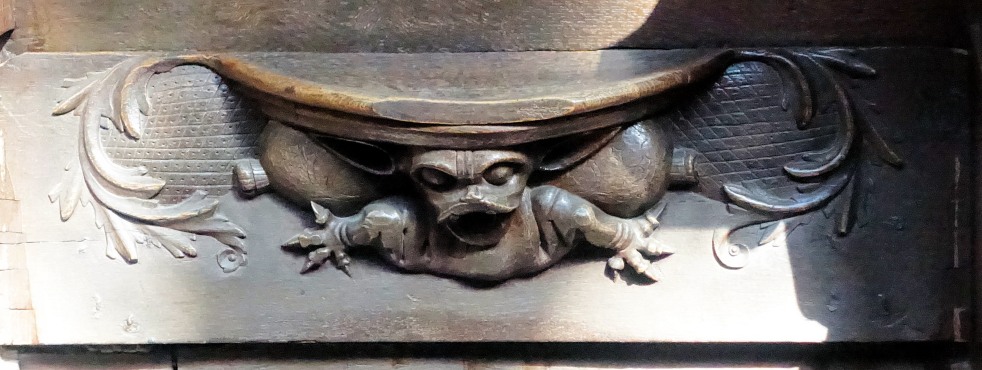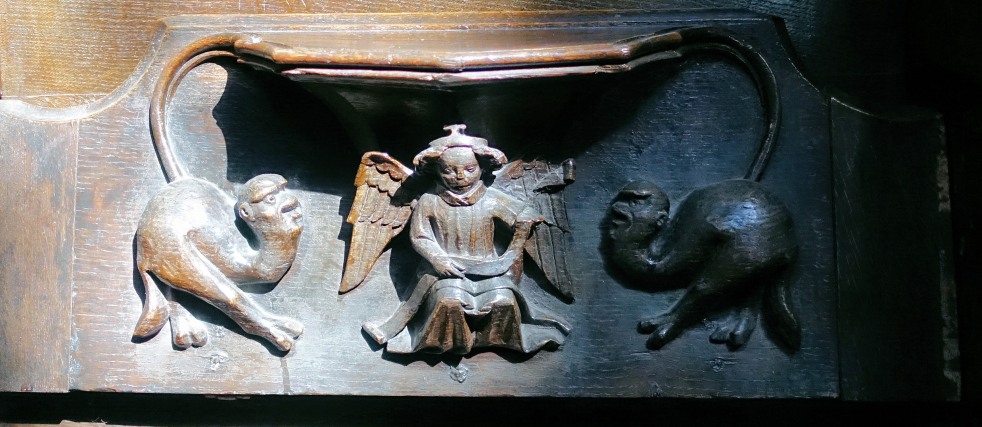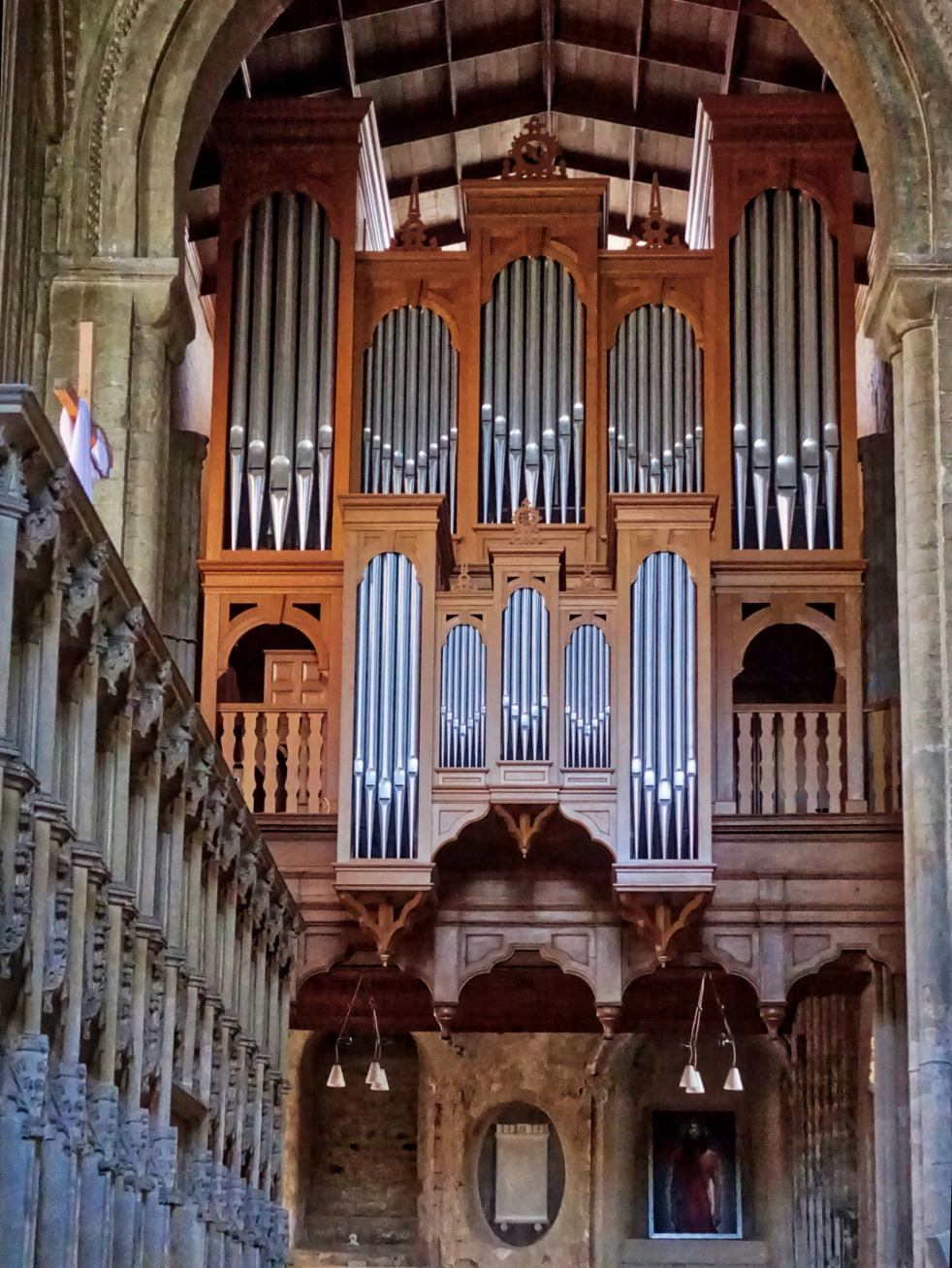When we started this blog early in 2017 we planned to restrict our church visits to the county that we both lived in – Hampshire. Now, more than two years on, with over 30 historic churches visited we have begun to wonder whether we should continue to be so restrictive in the area that we cover. Not that we have run out of suitable churches in Hampshire – there are plenty more, but most are in the furthermost corners of the county, entailing a drive of an hour or more. There is so much of interest considerably closer in the adjacent counties of Dorset, Wiltshire and Sussex and consequently we have decided that the title page of our blog should be amended to ‘Hampshire and Adjoining Counties.
Today’s destination, Christchurch Priory, just over the border in Dorset is a perfect example of an outstanding nearby church that we can now include. Just a 40 minute journey away but, on this occasion a stress-free 40 minute journey as it was by train rather than the usual car journey battling through the morning traffic. It was a glorious spring day and, as we passed through the New Forest and looked across an endless vista of heath and woodland, I thought how beautifully green and resplendent it all looked compared with the desert landscapes of Jordan and Israel that I had travelled through just a week earlier.

In 1094 the Ranulf Flambard, chief minister of William II supervised the start of construction of a substantial new church in the burgh of Twynham. By 1113 work was nearing completion when, according to legend, an incident occurred that not only had a profound effect on the local population, but became so well known throughout the Christian World that it became a centre of pilgrimage that endured for several centuries.
It had been noticed that a mysterious carpenter worked on the construction, but was present neither at mealtimes nor when wages were paid. One day, a large beam for the roof was found to be too short and was lowered back to the ground, a great embarrassment to all concerned as such huge timbers, cut from trees in the New Forest were expensive and scarce. The following morning the workers were astonished to find that the beam had been placed in the correct position with length to spare. The mysterious individual was never seen again and it was assumed that it was Jesus the Carpenter who had saved the day. Thereafter the building became known as Christ’s Church in Twynham, then later as the legend spread and the population grew, the town itself evolved from being called Twynham into being known simply as Christchurch.

The evolution of the Priory into the building that we see today took place over many centuries. It is the longest parish church in England with a nave of over three hundred feet. However, it is only by great fortune that the Priory survives at all as Henry VIII intended to pull down the church as well as the monastic buildings when the Priory was surrendered in 1539. The monastic buildings were pulled down soon after but, in response to a plea from the townspeople, the king granted the church together with the churchyard to the inhabitants of Christchurch to be used as the parish church in perpetuity.

Following the completion of Ranulf Flambard’s original church in the 12th century extensions and additions continued throughout the 13th century and by 1350 the nave would have looked very much as it does today, dominated by the towering Norman arches.

The Great Quire. The beautiful reredos behind the altar was carved between 1330 and 1360 and is an example of a Jesse Reredos – a term new to me that apparently means that it is a depiction of the ancestors of Christ, shown in a tree which rises from Jesse of Bethlehem, the father of King David. It is the original use of the family tree as a schematic representation of a genealogy. Fortunately the carvings survived the reformation although the statues that once occupies the empty niches did not.
Shown below are some of the 39 wonderfully carved Misericord seats in the Great Quire. The name comes from the term misericordia (literally “pity of the heart” to create an act of mercy) and refers to a small shelf that the monks could perch on during long periods of prayer yet still appear to be standing up. The earliest of these seats dates from 1210.







The oldest and the newest stained glass windows. The window on the left was originally fitted in Jumieges Abbey in Normandy in 1067 but, following the English invasion in the 15th century, it found its way to England and eventually to Highcliffe Castle, on the outskirts of Christchurch. It was donated to the Priory in 1976 and was installed in the south nave aisle. It depicts Saint Francis of Assisi and Saint Anne, but unfortunately at some stage of its life the glass had been fitted the wrong way round so that the painted detail of the faces have been lost to the weather.
The window on the right was installed in 1999 in the Montacute Chapel to celebrate the 900th anniversary of the priory. It shows a starry night in which the Cross of Christ dominates, surrounded by a pattern of circles, the symbols of Eternity and Perfection

The wonderfully carved interior of the Salisbury Chantry built for Margaret Pole, Countess of Salisbury in 1529. Henry VIII’s vandals made a half-hearted attempt at smashing the detail in the ceiling during the reformation and the niches no longer contain the original statues of saints, but still the original beauty of the structure shines through. Sadly the chantry is empty because the Countess was executed as a traitor on the King’s command and is buried in the Tower of London.

The magnificent organ has an impressive 4,500 pipes, some of which date from the Priory’s first organ installed in 1788

The mausoleum constructed for a Mrs Perkins who had a horror of being buried alive. She instructed that, on her death, her body must not be interred but instead placed in a structure near to the entrance of the free school so that the boys would hear her if she revived. Furthermore the coffin lid must not be screwed down and the door to the mausoleum must be able to be opened from the inside. Her wishes were fully carried out, but when her husband died in 1803 her body was interred and the structure sold and re-erected on its present site just outside the Priory wall.
Splinters Restaurant 
When we first arrived in the town, as we walked along the cobbled road towards the priory we passed an unassuming restaurant where I caught sight of a Michelin Plate logo on the door. I was reminded of the press release put out by the Michelin guide last year indicating that although not justifying a coveted Michelin star, this new ‘L’Assiette Michelin’ award would signify that when visiting the restaurant their inspectors had discovered ‘quality food’. And that is exactly what we found as well, simple fare of an exceptional standard, prepared with skill at reasonable cost. What more could one ask for? I was so impressed by my meal that I suggested to BQ that we should give the full five stars to which he hesitantly agreed. However on reflection I realise that considering his own unambitious selection of omelette and chips five stars would seem to be excessive, so four it is.
BQ’s Impressions
Mystic MW
No sooner had he returned from his non-stop tour of the ‘Holy Land’ than MW was telling me the astonishing story of the miraculous beam at Christchurch Priory. Had he caught something holy in his dip into the Dead Sea and the obligatory mud covering? More worrying to me was the thought that it might be catching. Also worried by his ‘carbon footprint’, despite journeying by camel at one point, he decided that we should go by train and therefore D/D could go green.
My constant moan that the Normans left so little of the Anglo Saxon churches to enjoy was completely blown out of the water when entering the magical Norman nave of Christchurch Priory.. The perfectly proportioned interior was the most decorated and beautiful Norman space imaginable. They may have acted like brutal conquerors, but they certainly knew about building and design. Thankfully, although the original monastery was demolished, very little damage was done to the church during the reformation, indeed it is now the longest parish church in the country. But size matters little unless it is accompanied by the wonderful vista when viewed from the entrance when the relative darkness of the nave bursts into full glory of the reredos lit in May sunshine by the later perpendicular windows in the chancel. For here is a church which glues the Norman and perpendicular in a seamless whole which is obvious from MW’s drone shots. If this was not enough the interior sparkles with fixtures and fittings worthy of any great cathedral.
For private prayer in the company of the blessed sacrament, St. Stephens chapel in the north transept is an exemplary intimate space. A Norman refuge with a contemporary stained glass window representing his stoning. After the first Christian martyr, celebrated in this country on Boxing Day, we move on to a collection of chantry chapels, the most notable of which is the Salisbury Chantry erected in memory of Blessed Margaret Pole, the Countess of Salisbury. Chantry Chapels are a feature of the 15th and early 16th century and they contained an altar where mass would be said for the family and relatives. Margaret Pole was a well connected lady, a Plantagenet with family ties to Edward IV and Richard III who, after a period of favour from Henry VIII, was imprisoned for two years in The Tower after her son, a priest, became a critic of the Monarch. After two years, at the age of 67, she was sentenced to beheading by the king. The gruesome tale of her bloody demise at the hand of an inefficient executioner is the stuff of horror. Beatified by the Pope in 1886 she is a martyr and I was grateful to the attendant who after many abortive visits in the past, allowed me inside the beautiful chantry in order to pray for her soul and that of her family.
This was an exceptional visit to a magnificent church in the lovely May sunshine and a walk through the park to the Splinters restaurant added its own charm. It seemed odd to award five stars to such an ordinary main course as omelette and chips, but yet again I allowed myself to be unduly influenced by MW’s enthusiasm for his lamb. However any establishment that can offer a black pudding starter plus a bread and butter pud deserves my unqualified approval.
Our lunch
-
- Black pudding, bacon and poached egg salad BQ
- Melon platter with sorbet MW
- Mushroom omelette, chips and salad BQ
- Lamb tagine, herby flatbread, hummus, coriander yogurt MW
- White chocolate bread and butter pudding BQ
- Orange pannacotta. MW
- The House Merlot BQ
- The House Shiraz MW
✪✪✪✪



Thanks again for another great read. My what a discovery this gem is. Your description and photos bring it alive and has got me moving. I’ve checked how to get to Christchurch on a train from London. Sometime later in the month I will take your guided ‘talk’ with me and explore the Priory for myself. And eat at Splinters of course!
All the best
Chris
LikeLiked by 1 person
It really is a stunning place and your description brings back all the memories I have of my few visits. I sadly attended a funeral in the Priory many years ago and whilst a very sad affair, the beauty and peace was outstanding.
LikeLike